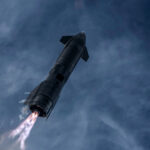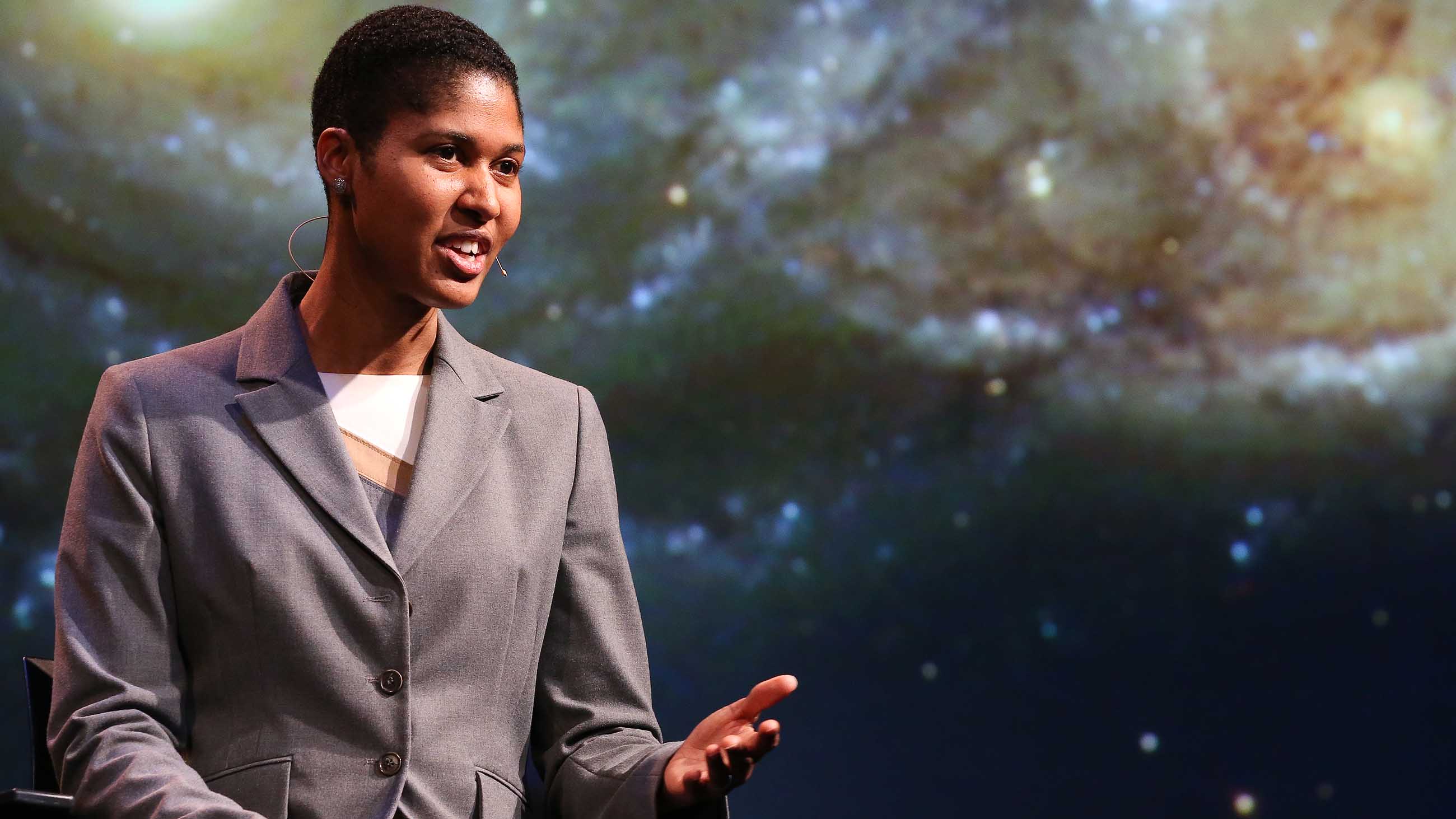Satellites With Social Goals: Five Questions for Danielle Wood
When Danielle Wood arrived at the MIT Media Lab this year, her first task was furnishing her workspace. But the name of Space Enabled, her new group at the lab, refers to a different kind of space. Wood believes technologies in orbit can benefit societies on Earth.
“Furniture buying is important,” she says, “but maybe building a satellite with Ghana is even cooler.”
A 36-year-old engineer and policy researcher, Wood is especially interested in small satellites that are relatively quick and cheap to get off the ground. She wants to work with partners such as national governments to use those satellites, and other space technology, for purposes like public health and resource management.
Wood got her degrees at MIT and worked most recently at NASA’s Goddard Space Flight Center. About 20 NASA satellites observe the Earth and gather data about its atmosphere, ice, water, and land; Wood worked on turning some of those data into useful resources for the public.
For example, satellite data about the risk of algal blooms in the ocean could help fishers decide where to take their boats. Data about deforestation and fires can help inform global forest managers. In 2016, Wood published a paper describing how satellite data on weather, terrain, and soil moisture could be part of an early warning system to predict malaria outbreaks.
For this installment of the Undark Five, Wood and I discussed her plans for Space Enabled, and why social sciences are a key piece of her mission. Our conversation has been edited for length and clarity.
UNDARK — A “small satellite” is defined as about 100 to 1,000 kilograms. Should I picture something the size of a refrigerator?
DANIELLE WOOD — We use the phrase “small satellite” not just to mean the satellite’s size, but actually to mean the philosophy people use in thinking about how they want to build satellites.
Throughout the satellite era, government programs especially have built really high-quality satellites that are very reliable and have a lot of functions. So the excellent satellites that NASA builds for science about the Earth and studying the universe, they are often the size of vehicles. They also last on the order of 15, 20 years. They cost hundreds of millions of dollars.
In contrast to that, the “small satellite” movement focuses on an agile approach to using technology that’s available today and getting it into space as soon as possible, and maybe planning for it not to last very long. We reduce the amount of testing, and we also buy equipment for the satellites that’s not specially designed for space, [such as] electronics designed for cellphones.
The small-satellite movement also tries to find launch opportunities that are not unique. Many universities and companies will look for ways to ride along with bigger satellites; they call it ride sharing.
UD — What are some of the ways that small satellites, or other space technology, can help society?
DW — My job at NASA was to help ask how to transfer all [their] great earth-science findings for societal benefit. I focused particularly on applications related to water resource management, food security, disaster response, transportation and energy, and we thought a lot about air quality and how it affects human health.
But satellite observation of the Earth is not the only kind of space technology that helps with all these kinds of applications. There’s also satellite communication and positioning and navigation, which are very important during disasters.
UD — What are the first big goals your group will tackle?
DW — At Space Enabled we believe that technology from space is underutilized and could be used more to support sustainable development. The United Nations list of sustainable development goals really highlights the key challenges for human society right now — to ensure that we’re reducing extreme poverty, that we’re ensuring access to clean water and food. So we’ll take that as our list of priorities. Then our goal is to apply methods including spacecraft engineering, complex system modeling, social science, and computer science to satellite data as well as design.
On the spacecraft engineering side, we are setting up a brand new satellite engineering lab. We want to ask, how do we best design satellites particularly for social applications? Especially with partners who are new to space. And how do we also think about a future way of building satellites differently? What we do now is design a satellite very carefully, build it and test it to make sure it works, then put it in space and use it for a while — and then we trash it. I’d like to explore ways of designing satellites so they don’t create unnecessary debris. I want to think about building modular designs, where you send up parts of spacecraft that can be mixed and matched together. We hope that that leads to a long-term outcome where satellites are even more cheap to access, but they’re also less likely to create debris in the long term.
Our whole life cycle looks like: starting relationships with communities, [using] social science [to study] that community, then proposing modeling exercises. We can try to imagine through the model both how we want to change the system and how it might change over time due to different environmental or economic factors. Then building new technology — which might involve building a satellite, if we’re lucky! But only if it’s appropriate given the modeling exercise. And then deploying that, and evaluating the outcomes using social science methods [such as interviews and observation].
I was privileged to travel in April to visit several countries to explore potential collaboration. I also have been speaking at several events hosted by the United Nations to discuss the role of space technology in sustainable development. This summer I have students working with me who bring skills in the areas of complex systems modeling, satellite engineering, and data science.
UD — The way you combine engineering and social science is unusual. Do you ever encounter resistance to that approach?
DW — Either as a student or as a professional, I’ve often had to buck traditional cultural trends. As one chooses classes and degree programs, and as one is trying to develop as a professional, it’s very hard to be effective as both a strong engineer and a strong social scientist. So I’d say it’s been a personal journey of challenges to figure out where I could work, where I could actually use both sets of skills, and what kinds of jobs were appropriate. It was a very personal choice, and it wasn’t easy to find that opportunity.
As a child, if you just asked me what I enjoyed, I would have said I love math and I like English class. And the fact that I loved both made sense to me. But the older I got, the more I realized that enjoying both words and numbers was, like, apparently unusual and considered awkward. I wish that all students would have the freedom to explore both sides and not feel artificially separated.
UD — What can we gain in science from combining social science and engineering?
DW — I do believe that so many of the challenges facing the world today require multiple kinds of intelligence and creativity to address. Almost all of the easy problems have already been solved.
Think about, for example, communities that are in vulnerable locations such as small island states or higher latitudes in the Arctic. Many of them are already facing the effects of climate change. How do we conserve both the natural environment and their social cohesion? That has to be done with a combination of engineering and social science. We could make large mistakes if we just bring a scientific point of view.
Ultimately we’re also taking great responsibility to be humble in the face of our partners. If we’re working with leaders from a community in Alaska or from a small island nation, we consider them the experts on their own home and their own culture and their own needs. So their knowledge, which may have quite a different format than our academic knowledge, is also very relevant.
That’s part of what we mean when we say we want to advance justice with space technology. So many groups around the world have experienced injustice. We want to now give voice and listen to the expertise of these communities and look for ways to use our technology to support their goals — rather than how it’s commonly been done, which is that technology is used to exploit those who are less powerful.
Elizabeth Preston is a freelance writer whose work can be found in New Scientist, Discover, Quanta, The Atlantic, and STAT News, among other publications.











Comments are automatically closed one year after article publication. Archived comments are below.
What expertise does social science bring to bear on the problem of global warming that climate science does not already have? The same question applies to politicians and anyone else who has never studied climatology and attempts to make pronouncements. Even climate scientist have enormous difficulty separating their feelings about the outcome from their research. Their findings have to be the result of disinterested research. Otherwise it will be challenged.